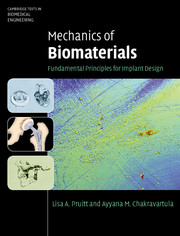Book contents
- Frontmatter
- Contents
- Symbols
- Prologue
- Part I Materials
- 1 Biocompatibility, sterilization, and materials selection for implant design
- 2 Metals for medical implants
- 3 Ceramics
- 4 Polymers
- 5 Mechanical behavior of structural tissues
- Part II Mechanics
- Part III Case studies
- Epilogue
- Appendix A Selected topics from mechanics of materials
- Appendix B Table of material properties of engineering biomaterials and tissues
- Appendix C Teaching methodologies in biomaterials
- Glossary
- Index
- References
2 - Metals for medical implants
from Part I - Materials
Published online by Cambridge University Press: 05 June 2012
- Frontmatter
- Contents
- Symbols
- Prologue
- Part I Materials
- 1 Biocompatibility, sterilization, and materials selection for implant design
- 2 Metals for medical implants
- 3 Ceramics
- 4 Polymers
- 5 Mechanical behavior of structural tissues
- Part II Mechanics
- Part III Case studies
- Epilogue
- Appendix A Selected topics from mechanics of materials
- Appendix B Table of material properties of engineering biomaterials and tissues
- Appendix C Teaching methodologies in biomaterials
- Glossary
- Index
- References
Summary
Inquiry
All metals, with the exception of high noble metals, are susceptible to corrosion. This problem is exacerbated in the body, where implants must function in aqueous environments under complex loading and often utilize designs that contain inherent stress concentrations and material discontinuities. How would you design a modular hip system composed of metal components that minimizes the likelihood for fretting and crevice corrosion?
The inquiry posed above represents a realistic challenge that one might face in the field of orthopedic biomaterials. At a minimum one would want to minimize the galvanic potential of the alloys involved in the implant design. Fretting is the loss of material owing to the rubbing or contact of components; to minimize this type of surface degradation it is necessary to utilize designs that optimize component tolerances for device fixation. Crevice corrosion occurs in metal components that contain fissures, notches, or other geometries that facilitate local changes in the environment. This type of corrosion is further enabled in the presence of elevated stresses or stress concentrations within the component. To minimize fretting and crevice corrosion in a modular hip it is necessary to diminish geometric gaps at junctions such as the Morse Taper (where the stem and acetabular head join) and to keep the stem and neck at reasonable lengths in order to reduce bending stresses at the stem-neck juncture. The case study presented at the end of this chapter addresses this issue.
Historical perspective and overview
Metals have been utilized in medical implants for several hundred years; in fact gold has been used as dental material from as early as 500 BC and noble metals have been employed in structural dentistry for use in fillings, crowns, bridges, and dentures since the 15th century (Williams, 1990). Noble alloys contain varying percentages of gold, palladium, silver, or platinum. High noble metals are metal systems that contain more than 60% noble metals (gold, palladium, or platinum) with at least 40% of the metal being composed of gold. It is known that gold was used in the 16th century to repair cleft palates; gold, bronze, and iron evolved as suture wires over the 17th–18th centuries; and steel plates were commonly employed as internal fixation devices by the early 19th century (Aramany, 1971; Williams et al., 1973). By the mid-1920s, stainless steels were introduced as implant materials and a decade later cobalt-chromium alloys were utilized in the body to provide enhanced corrosion resistance (Park and Bronzino, 2003). Titanium found its use as a surgical material shortly thereafter (Leventhal, 1951). Much of what motivated the development of metals as implant materials was the need for both strength and corrosion resistance in load-bearing devices.
- Type
- Chapter
- Information
- Mechanics of BiomaterialsFundamental Principles for Implant Design, pp. 26 - 69Publisher: Cambridge University PressPrint publication year: 2011



